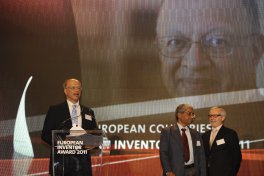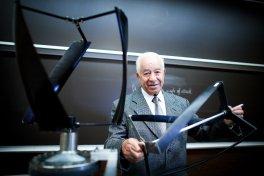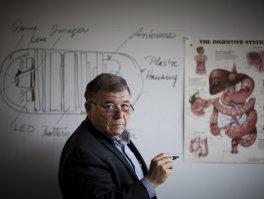Ashok Gadgil, Vikas Garud
UV water disinfection device
Winners of the European Inventor Award 2011 in the category Non-European countries
Lack of access to safe drinking water is a global crisis, with about a billion people worldwide lacking access. Ashok Gadgil's and Vikas Garud's UV water disinfection device offers a cost-effective, easy to use solution for water purification. The low maintenance system can be implemented in even the most remote areas of the world.
In July 2010, the UN General Assembly pronounced that access to safe, clean drinking water is a basic human right. This declaration came in response to the extreme need for water purification systems. Currently, water-borne diseases, caused by unsafe drinking water, result in the deaths of 2 million children and infants each year, almost exclusively in poor populations of developing countries.
Various water purification systems exist, but their cost and requirement for a pre-existing infrastructure prevent them from being available to the developing world.
One method of water purification derives from exposing water to UV light. These systems consist of a UV lamp encased in a quartz or Teflon cover which is then placed underwater to disinfect the water supply. These systems are costly due to their need for elaborate pump systems. The lamps also demand extensive maintenance because of accumulation of residue.
Ashok Gadgil with the help of Vikas Garud developed a modified UV water disinfection device. Their invention delivers the same positive results as its predecessors, without the high cost or maintenance.
Gadgil and Garud decided to place the UV lamp above water tanks, instead of submerging the devices underwater. This removes the problem of residue. Their design also uses gravity and a carefully planned hydraulics design to ensure even water flow, eliminating the need for a pump system.
The new UV disinfection device is smaller and uses less energy than earlier systems. Weighing only 15 pounds, the system requires only a 40 watt UV light bulb to disinfect 1 000 litres of water per hour. It can be used outside of electrical grids by using a car battery or a small photovoltaic panel for power. For example, earliest field demonstration units in India were powered by a 12 V car battery and by a stand-alone photovoltaic power panel respectively-- both in areas where grid power was not available.
After WaterHealth International licensed the technology from UC/LBNL, Gadgil and Garud helped them develop the product, as well as other related equipment like filtration, for use in developing countries.
By 2010, the systems had been installed in more than 10 countries and were bringing clean water to more than 2 million people.
In 2008, WaterHealth was offering triple-filtered, charcoal-filtered, UV-disinfected safe drinking water for €0.002 per litre.
Ashok Gadgil teaches at UC Berkeley and is the Director of the Environmental Energy Technologies Division at the Lawrence Berkley National Laboratory. He also creates inventions for development aid projects. Thousands of his energy efficient cook stoves are used by refugees in Darfur, and his process for removing arsenic from drinking water will be pilot-tested this year in India. Vikas Garud currently works with H2O Innovation USA specializing in applications of membrane processes for water and waste water treatment.
Contact
European Inventor Award and Young Inventors Prize queries:
european-inventor@epo.org Subscribe to the European Inventor Award newsletterMedia-related queries:
Contact our Press team#InventorAward #YoungInventors


